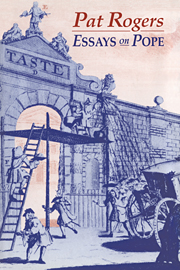Book contents
- Frontmatter
- Contents
- Preface
- Acknowledgements
- List of abbreviations
- 1 Pope and the syntax of satire
- 2 The politics of style
- 3 Form and pattern in the Pastorals
- 4 Windsor-Forest, Britannia and river poetry
- 5 Faery lore and The Rape of the Lock
- 6 Timon's Villa and Chatsworth
- 7 A drama of mixed feelings: the Epistle to Arbuthnot
- 8 The name and nature of Dulness: proper nouns in The Dunciad
- 9 Pope and the social scene
- 10 Blacks and poetry and Pope
- 11 The case of Pope v. Curll
- 12 Pope and his subscribers
- 13 The Burlington circle in the provinces: Pope's Yorkshire friends
- 14 Pope and the antiquarians
- Index
5 - Faery lore and The Rape of the Lock
Published online by Cambridge University Press: 18 December 2009
- Frontmatter
- Contents
- Preface
- Acknowledgements
- List of abbreviations
- 1 Pope and the syntax of satire
- 2 The politics of style
- 3 Form and pattern in the Pastorals
- 4 Windsor-Forest, Britannia and river poetry
- 5 Faery lore and The Rape of the Lock
- 6 Timon's Villa and Chatsworth
- 7 A drama of mixed feelings: the Epistle to Arbuthnot
- 8 The name and nature of Dulness: proper nouns in The Dunciad
- 9 Pope and the social scene
- 10 Blacks and poetry and Pope
- 11 The case of Pope v. Curll
- 12 Pope and his subscribers
- 13 The Burlington circle in the provinces: Pope's Yorkshire friends
- 14 Pope and the antiquarians
- Index
Summary
Everyone knows that Pope added the machinery of sylphs and gnomes when he revised The Rape of the Lock in 1714. And most people – aside from John Dennis – think it was a valuable addition. However, the precise imaginative territory opened up by this means has never been charted in any detail. The declared Rosicrucian origins of the machinery appear to have disabled criticism in a puzzling way. I wish to offer a threefold argument. First, that the gnomes are as important as the sylphs in the design. Second, that Pope writes in a tradition of rustic ‘faery’ lore, involving Shakespeare, Spenser, Drayton and others. And third, a relatively minor point, that the work of William Diaper – notably Dryades, published in December 1712 – has a perceptible relevance to the additions Pope made.
On July 1712, in the Spectator no. 419, Addison supplied the classic definition of the ‘fairy way of writing’. In this species of composition, he tells us,
the poet quite loses sight of nature, and entertains his reader's imagination with the characters and actions of such persons as have many of them no existence, but what he bestows on them. Such are fairies, witches, magicians, demons, and departed spirits.
Addison then goes on to specify the qualities required of a poet attempting this mode:
It is impossible for a poet to succeed in it, who has not a particular cast of fancy, and an imagination naturally fruitful and superstitious. […]
- Type
- Chapter
- Information
- Essays on Pope , pp. 70 - 84Publisher: Cambridge University PressPrint publication year: 1993

